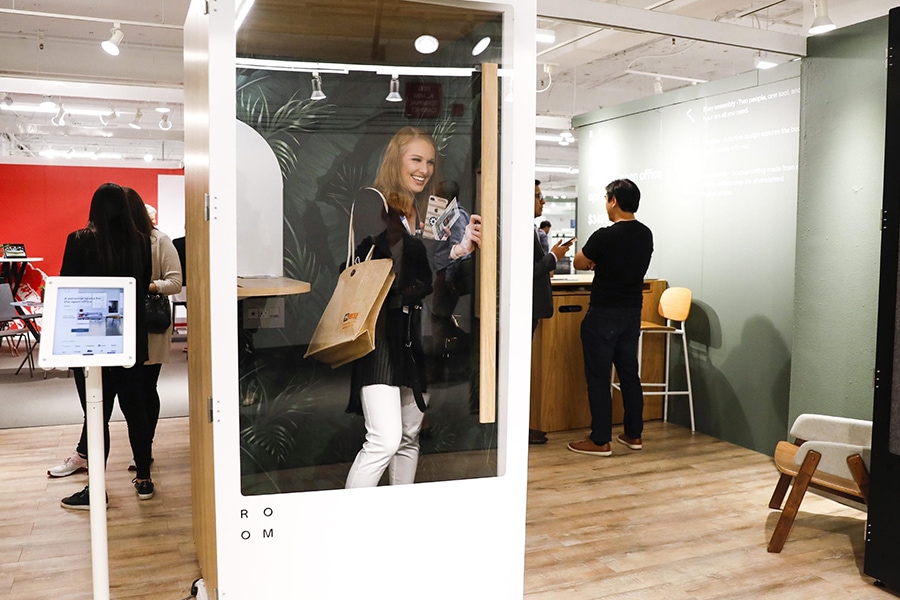Hate the open office? Think it’s too loud? Enter the ‘phone booth.’
By Abdel Jimenez

Gabriella Massey, a junior interior designer with Bailey Edward, takes a peek at a phone booth by ROOM during NeoCon at the Merchandise Mart on June 10, 2019. (Jose M. Osorio/Chicago Tribune)
As Generation Z starts entering the workforce, office interior designers are creating flexible workspaces that offer the privacy young workers — those born between 1997 and 2012 — demand.
Design experts say privacy is important to this young generation of workers in order to escape the noisiness that has enveloped the open office, so they are drawing inspiration from a surprising place: the phone booth, an obsolete space most members of Gen Z have probably never entered.
Tall and narrow “phone booths” are making their way into offices to insulate sound and provide a quiet space where employees can step away for a phone call or to focus on work. Most models have one glass side, but others are all glass, providing a fishbowl-like experience. There’s no built-in phone, but there is a countertop, seat, power outlets, a light and ventilation.
The open-office concept was heralded as a way to lower costs and promote interaction and collaboration among employees throughout organizations. But a study last year by Harvard University researchers found, among other things, that workers miss their privacy.
Young workers make up an increasingly large section of the labor force as baby boomers continue to retire. According to consulting firm BridgeWorks, Gen Z is estimated to account for 63 million people in the U.S., and the eldest of this group are starting to trickle in the workforce. As more young people start working, furniture makers are coming up with products to help employers attract young talent.
Dozens of vendors showed off office phone booths recently at NeoCon, the annual commercial interior design show at Chicago’s Merchandise Mart.
“It’s really difficult to find privacy or quiet in the open floor plan,” said Brian Chen, co-founder and CEO of Room, a designer of phone booths. “We are definitely noticing that companies are seeing a big mistake in putting all sorts of different activities in one single floor plan, and that is a recipe for people being stressed or unhappy in the office.”
Room has sold its phone booth offices to more than 1,500 businesses since launching in May 2018. The company, which sells its phone booths for about $3,500 each, expects annual sales to reach $30 million this year, Room spokeswoman Morgan Albrecht said.
Phone booths give employees the option of stepping into someplace quiet without walking too far from their desk, said Jonathan Webb, vice president of workplace strategy at KI, another phone booth manufacturer at NeoCon.
“I think that companies are figuring out ways for their entire workplace to be more flexible overall,” Webb said.
A big part of Webb’s job is helping companies retain young workers through design. In order to provide a more inviting office, Webb said he examines the study environments of younger workers throughout their collegiate years. What he found is that newly hired graduates want a flexible office that accommodates their different work styles.
“I think the death of open offices is over-exaggerated,” Webb said, “However, I think the death of static workstations is more accurate. Companies are figuring out ways for their offices to be more flexible overall and furniture plays a big part in that design.”
In addition to phone booths, KI also offers “hackable” office designs that allow employees to adjust their workspaces when moving between individual work and group projects, Webb said. Hackable offices incorporate movable furniture pieces, adjustable privacy screens and other customizable elements.
“Privacy is still a big deal,” Webb said. “Even for Gen Z. They still want to have the ability to be private.”
KI’s phone booths can cost as much as $7,000 each. But companies that don’t have money to spend on big-ticket items are getting creative.
Verano Holdings, a medical marijuana company in the River North neighborhood, installed its version of the phone booth office earlier this year at a cost of a couple thousand dollars each. The company’s chief marketing officer, Tim Tennant, said he was looking into affordable office booths but couldn’t find one.
“We decided to custom-build these small offices on our own after looking at the market,” Tennant said. “It became easier to make it ourselves.”
With the help of a contractor, Tennant said the company added three phone booths to previously unused space. “Immediately, they were a big hit,” he said.
Tennant said employees had been taking work home because the office was getting rowdy, making it hard to concentrate and lowering the company’s productivity.
Adding phone booths boosted productivity by 30 to 40 percent, Tennant said.
“This is why prioritizing choice and flexibility is so vital to a successful workplace. It gives employees with different working styles the ability to self-select,” International Interior Design Association executive vice president and CEO Cheryl Durst said in an email.
Chicago-based Tock, the online restaurant reservation system, employs less than 100 workers but Brian Fitzpatrick, co-founder and chief technology officer, said the company bought 10 office booths from Room in order to provide more private space for employees.
“We saw that we had way too many people and fewer conference rooms,” Fitzpatrick said. “These conference rooms were a waste of space if only one person was using them. So we went online to search for a cheap and quiet option.”
